Horse Mushrooms – Edibility, Identification, Distribution
Agaricus arvensis
Also discussed here: The Prince (Agaricus augustus), Macro-Mushroom (Agaricus urinescans) and Field Mushroom (Agaricus campestris)
- Edibility – 4/5
- Identification – 3/5 – beware of yellow stainer (agaricus xanthodermus) – see below for full details
- Distribution – 3/5 – These once abundant mushrooms are becoming less common due to habitat loss
- Season – June to December
- Habitat – fertile pastures (without artificial fertilisers), verges, hedgerows, wood edges.
A horse mushroom in its prime is a thing of great beauty and superb flavour. It also has the curious dual distinction of being commonly misidentified and widely underrated. On the one hand it is pounced upon as a “proper mushroom” by the non-fungi literate because it resembles its tamed relatives (mostly derivations of agaricus bisporus), blisfully ignorant that the poisonous yellow stainer (Agaricus xanthodermus) is virtually identical (at least until eaten). On the other hand horse mushrooms tend to be overlooked by wild mushroom aficionados in favour of their weird and wonderful woodland cousins. How often do you see horse mushrooms on a menu compared to chanterelles, ceps or even vile “pretend” wild mushrooms like enoki?
I have touched before upon the dangers of making assumptions about mushrooms based on their general appearance rather than precise mycological characteristics (see “Mushrooms v Toadstools”) and nothing illustrates the point better than horse mushrooms and yellow stainers. The rule is quite simple: If the base of the stipe turns chrome yellow when bruised, don’t eat it. Quite a simple test for the mushroom world really, yet hundreds of people still get sore tummies every year from eating the really quite helpfully named yellow stainer. These are often people who wouldn’t dream of eating less conventional looking woodland mushrooms and feel comforted by the illusion of familiarity.
The idea of people stravaiging about the countryside grabbing any fungi that reminds them of what they see in the shops becomes rather more worrying when you consider that death caps can lurk in the same hedgerows and field edges as horse mushrooms. While the yellow stainer could put you in the loo for a few hours, the death cap could put you in a box for considerably longer…
That’s enough scaremongering for one post. It is always best to focus on positively identifying a species rather than over-dwelling on things it might be – if you can tick off the identification points for young and old specimens in these two pictures you have very little to worry about. And if you aren’t sure…NEVER MUNCH ON A HUNCH!
The pink gilled caps of young horse mushrooms have a sweetly fragrant aniseed aroma that I rate nearly as highly as prime ceps, and certainly in my top table of gourmet wild mushrooms. The texture can be a wonderfully rare combination of light, crisp and succulent. This is truly a gastronomes mushroom and it is, paradoxically, only its physical similarity to cultivated mushroom that keeps it out of top kitchens. Young caps, simply sliced, seasoned, dressed with a light oil and lemon juice and served with wood sorrel, sweet cicely (which echoes the aniseed aromas – see recipe here) and a few shavings of parmesan, is one of the finest mushrooms dishes you can eat. Older specimens will have lost some pizzazz, but make up for that in size and meatiness (just like humans really). They are still the makings of epic breakfasts and the finest soups though.
Horse mushrooms are still relatively common despite being generally on the decline due to habitat loss. They earned their name due to a liking for generously (horse) manured fields. They are just one of many excellent wild mushrooms (waxcaps, field mushrooms, parasols etc) that thrived among the convivial husbandry of yore but are dwindling amid the industial-chemical agro-business of today. The phosphate-heavy fertilisers and fossil-fuel based practices that many farmers use to grow unnaturally green silage generally inhibit mycorrhizal activity – a bit of an expensive (financial and environmental) own-goal when you consider that many of these fungi actually stimulate plant growth. Such is the pressure on natural grassland, there is the very real prospect of the once prolific field mushroom (agaricus campestris) going off the wild food menu altogether in some areas of the UK. Fortunately, the superior and more substantial horse mushroom is a little more versatile in its choice of habitats: I find most of mine in wood edges and hedgerows, often growing in “family groups” and rings that can make for a good harvest of young and mature caps, and still leave plenty behind to perpetuate the colony. Please read and share this on sustainable mushroom picking. Sometimes horse mushroom rings can be 10’s or even 100’s of years old – check out this amazing one on the Welsh border (NB: It isn’t a sheep formation dance troop!):
If, like me, you find many of your horse mushrooms on roadside verges, you should be aware of their capacity to absorb and concentrate heavy metals – notably cadmium and copper. While there is some doubt how much of these are actually absorbed through the gut wall, it isn’t a good idea eat too many picked from busy roadsides, but I am comfortable with a handful a year from our quiet Galloway lanes. Incidentally, the ability of fungi to absorb both ground and airborne toxins is a hot field of research at the moment: check this out and this fantastic insight by fungi-guru Paul Stamets. Then order this – it will blow your mind!!
There are at least 40 species of agaric growing wild in the UK – and countless other cultivated strains growing in darkened chambers. Some of the wild cousins are well worth keeping your eye out for:
– Macro mushroom (A. urinascens) – very similar to horse mushrooms, though getting even larger (up to 30cm across cap compared to 25cm with horse mushrooms). ‘Cogwheel’ less pronounced, base of stem has wooly scales, smells of aniseed – not quite so good to eat, though still excellent if eaten soon after picking.
– The Prince – (A. augustus) – This should rightfully be declared King of the Agarics as it is the tastiest of the lot, with sweet almond nuances floating above the aniseed and mushroom aromas. It is also enigmatic in when and where it chooses to appear – beneath conifers seem to be its preferred throne. Cap up to 25cm, cream with brown scales, club shaped stipe with brown tipped shaggy fibres when young, gills white then brown then chocolate. Sublime.
– Field mushrooms – (A. campestris) – a dewy young field mushroom is a very lovely, fragrant thing, though lacking the heady aromatics of some of its kin. Apply the standard tests for yellow stainer and harvest sensitively. Field mushrooms (and other mushrooms to a lesser extent) appear to enjoy a ‘bumper year’ at 7 year intervals – though this may coincide with ideal growing conditions. Or witchcraft. Know them by the overhanging skin of the cap, narrowing stipes, simple fragile rings, and faintly blushing flesh.
Related Pages:
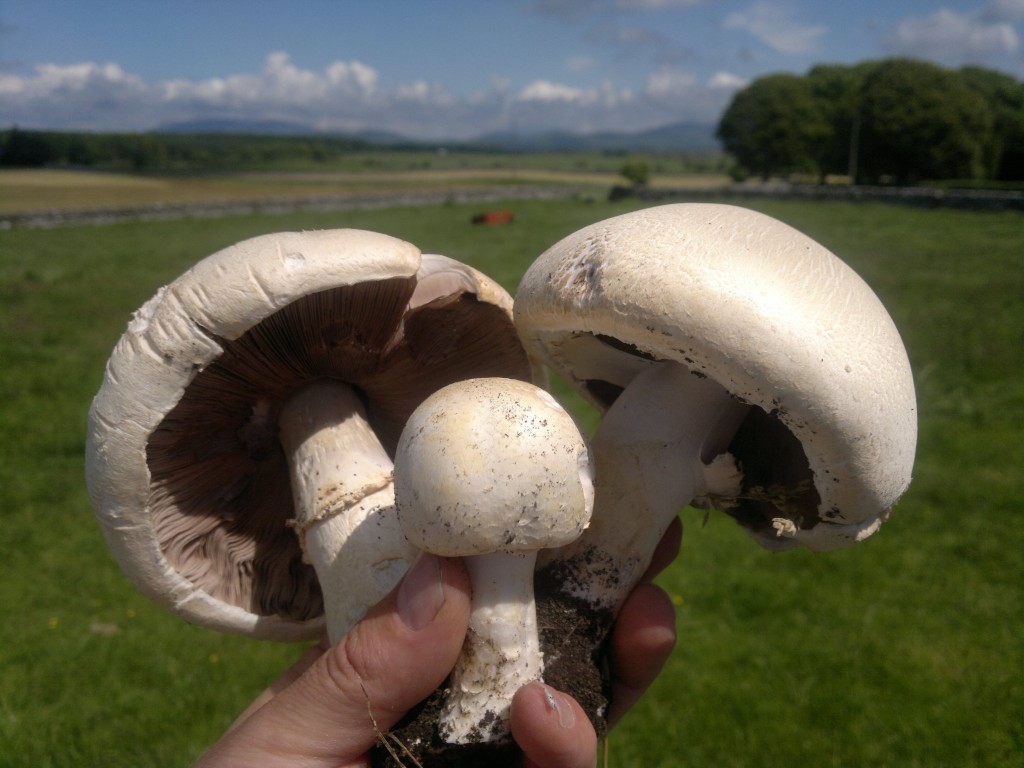
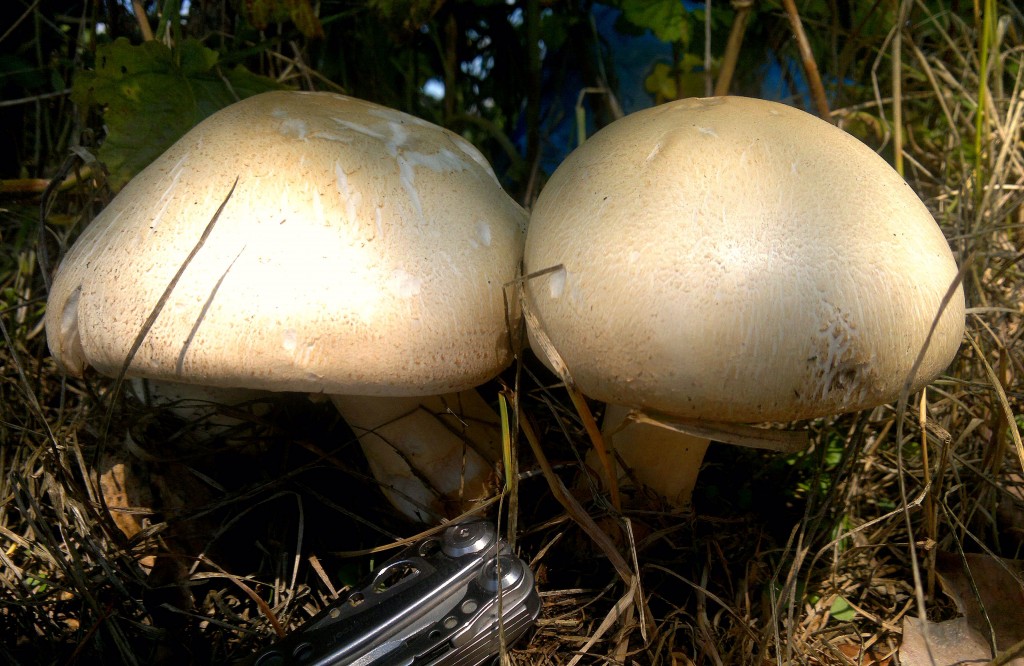
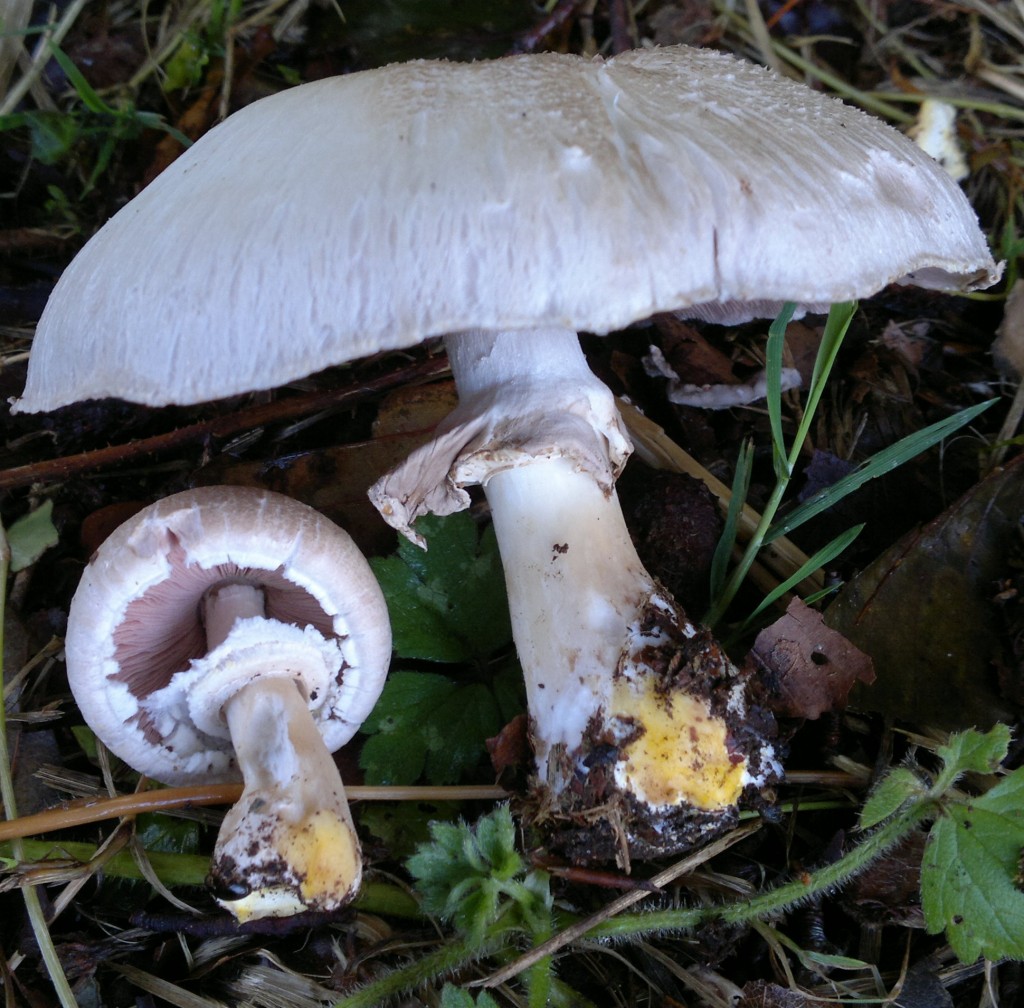
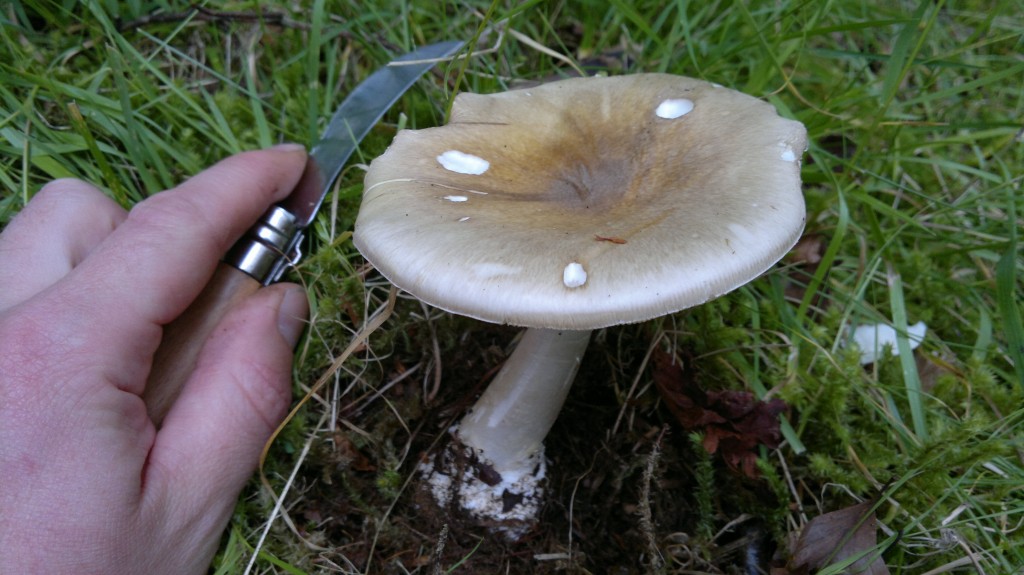
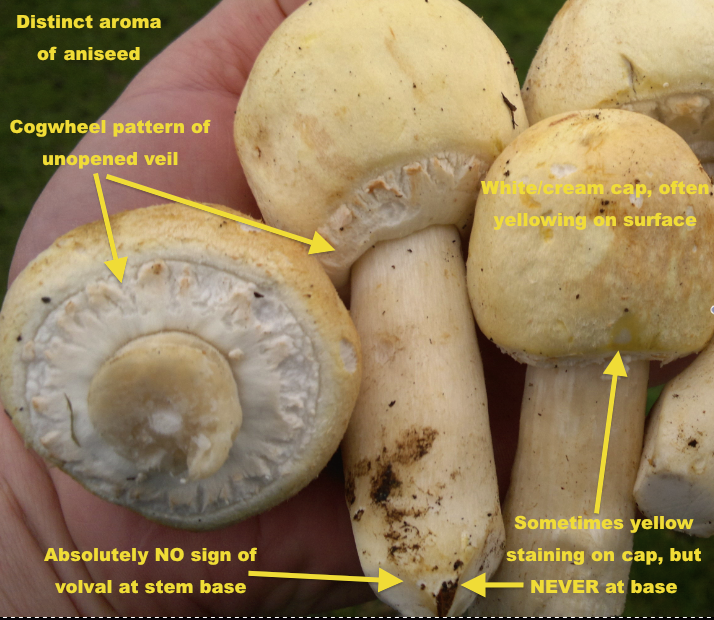
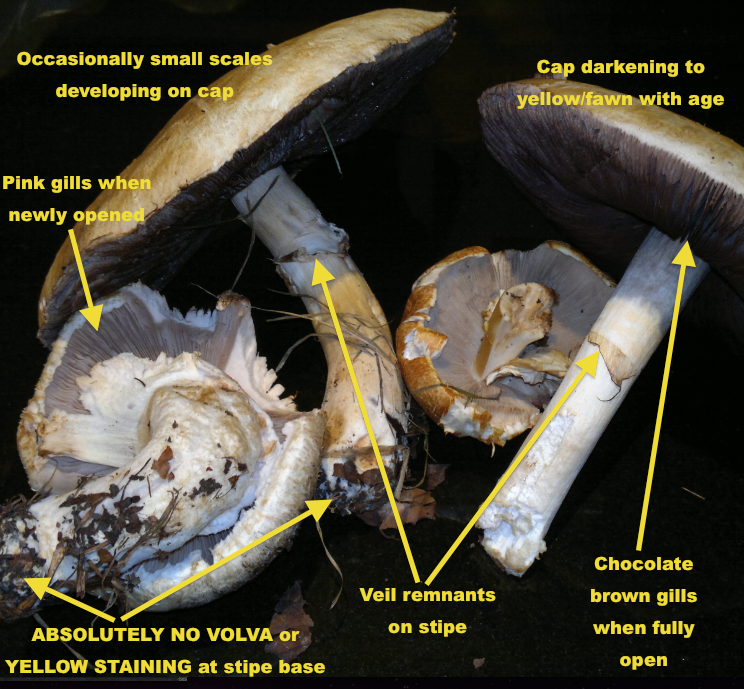
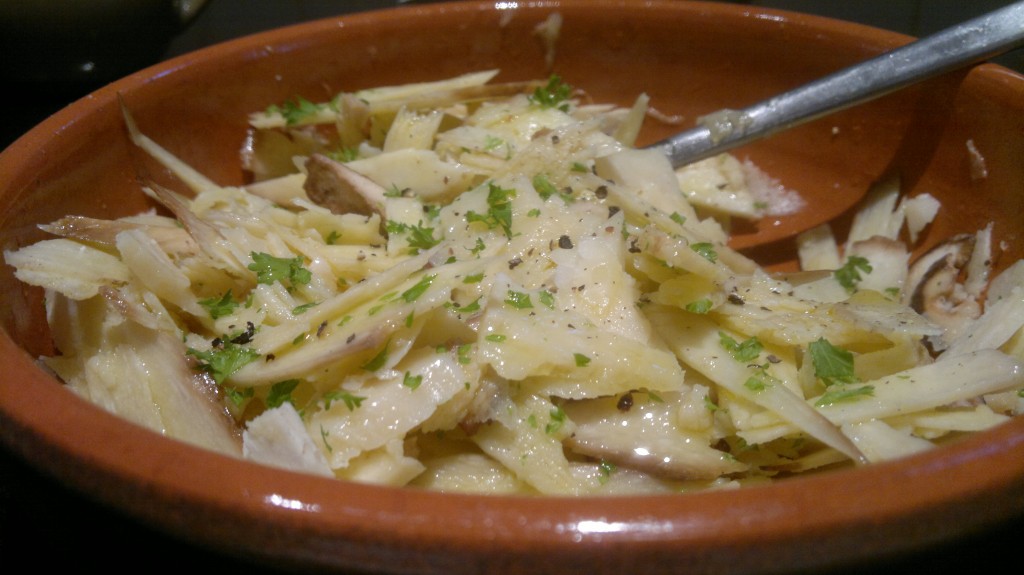

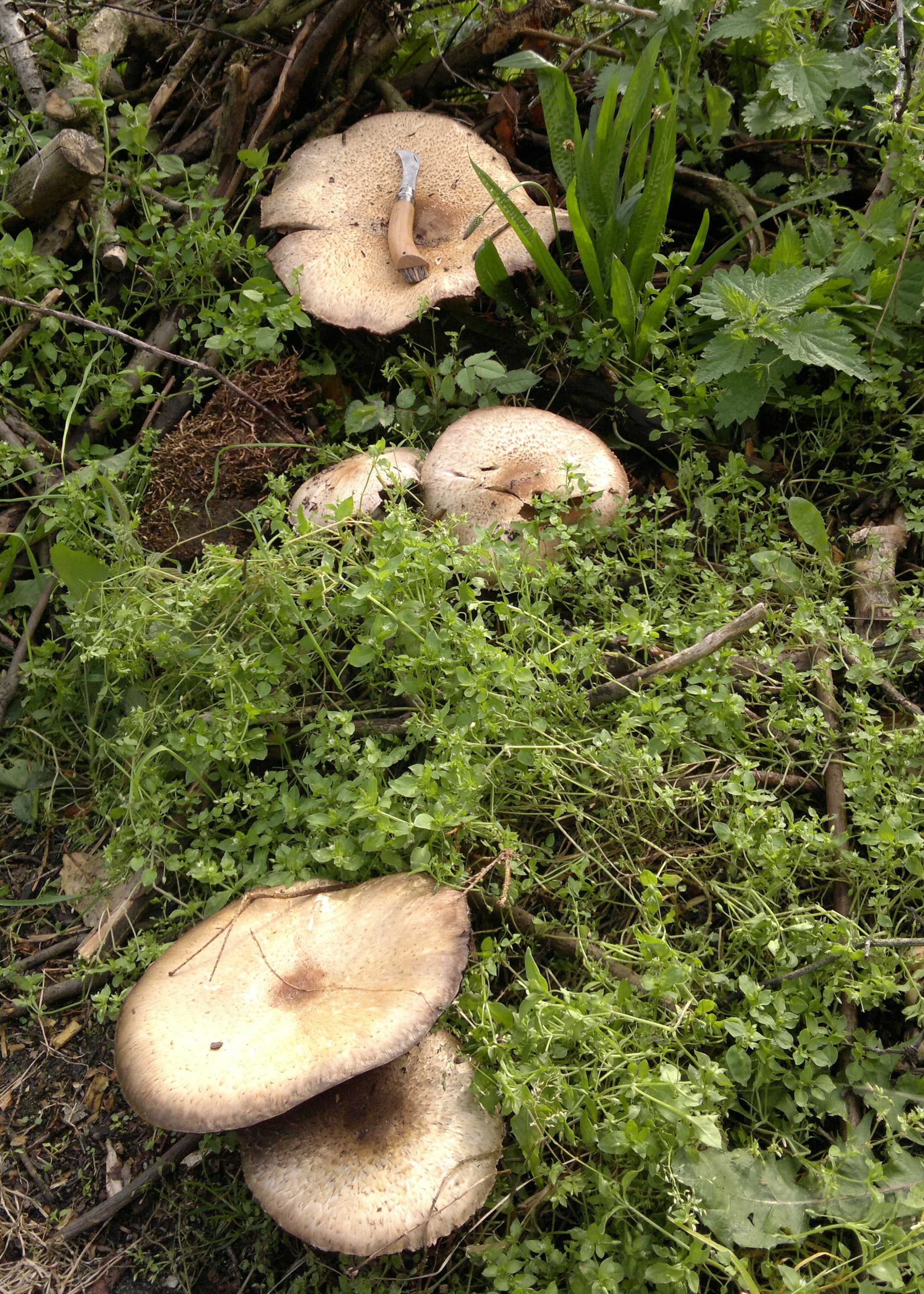
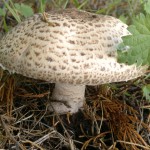
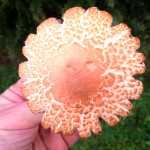
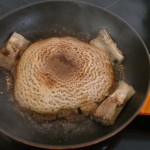
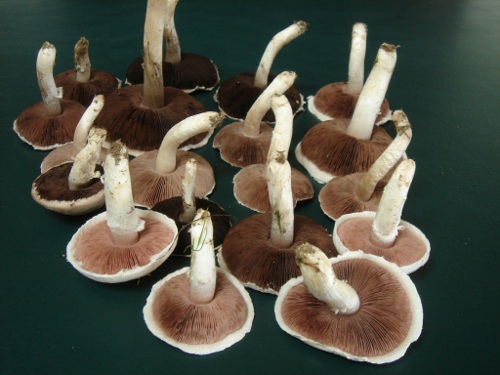
26 Comments
Um, you say vile enoki mushrooms, whilst not a fan of the cultivated variety (or oysters etc), you do realise that enokitake are Flammulina velutipes, the Velvet Shank (or Foot)? A fine wild winter find… 😉
Um, yes thanks Ben, I do know that – as I describe in the linked article and in this article on velvet shank – http://www.gallowaywildfoods.com/?page_id=883. I often find pale “enoki” under the bark of host trees – but I never pick them until they have matured a little. The small brown (pre-slime) caps are one of my very favourite mushrooms – like fungal sweeties. I like to eat them raw in elf cups with wild leek shoots – really excellent.
Thank you so for your enlightening article.
It was well written and the photos make it clear.
I’m off to pick some of what I am now confidently calling Horse mushrooms.
Another point worth making is I remember a long time ago I picked what I thought
were good eating agaricus. Upon cooking them however I found them to be watery and really smelt revolting! Don’t know what they were but only the desperate would have dared eat them.
Thanks for this great post.
Horse mushrooms are quite rare near us but this week it’s gone bonkers and I’ve gathered a kilo a day for the last 3 days.
Rachel Roddy’s (from The Guardian) mushroom goulash recipe is phenomenal and strongly recommended.
So my mother suddenly brought these home & we made its masala curry… But I was worried if they were edible..so we Googled n I reached here… I’m happy I’m not dying tonight
What is the mushroom that looks like a field/horse mushey but when yu cut in halves it slowly turned red ?
Try the blushing wood mushroom, agarics silvaticus
Thank you for sharing and spreading awareness! This article would help new mushrooms enthusiasts how to spot an edible mushroom from the deadly ones especially for people who would love to hunt mushrooms in the wild
Ran across your site while looking for ways to preserve the harvest from my friend’s patch. I really do appreciate the way you’ve cleared up the yellow staining. Many sources discussing meadow (campestris) mushrooms just say to discard if they stain yellow. When I saw the faint yellow staining of the caps of these, I had a small panic, despite my friends’s testimony of eating them “for years”. I did decide that it was very different from the bold and neon xanthodermus and the staining actually faded while I researched.
But your explanation of the brilliantly yellow cut stem is by far the clearest remark I’ve run across online or in print to differentiate these and A. campestris from their stinky cousin. Thanks!
Did you confirm that these are edible? The mushrooms in my yard sound exactly as you describe. They turn a bit yellow when pinched at the base or cut, but the yellow fades and it’s not a bright yellow. Also, the ones in my yard smell delicious. I’m just nervous because I don’t have anyone who’s said ‘oh, yeah, I’ve been eating those for years.’ Thanks!
Hi Mark.
To my delight I appear to have a large ring of mushrooms growing in my garden! The ring is maybe 8 feet in diameter and is composed of 10 or 15 fruiting bodies, it is partly in a large flowerbed (poorly maintained obviously) and partly in the ajoining lawn. Naturally my first plan was to rush out with the frying pan and fill it to the brim but the little voices stopped me and now I’m browsing your website and also a couple of fine books on mushrooms. Hopefully you can give me a pointer or two to help me identify these. They look exactly similar to both a field mushroom and (you guessed it) a yellow stainer. The less obvious things are that there is a yellow tinge to the base where I’ve picked it but it doesn’t bruise yellow at all. It smells nice, like a mushroom and not like ink but it has a large, tatty veil with slight scaling. Personally I think it looks like a yellow stainer other than no yellow stain or nasty smell. Any thoughts on this? I can get a photo or two if you like. Thanks for your time.
Hi Steve,
I can’t really add much to the detailed information on ID already on this page.
Cheers, Mark
Great tip on avoiding the Yellow Stainer how if it bruises yellow to stay away from it. This mushroom is a great substitute for the portabella in cooking and I hope to find one to eat.
Thanks!
You say if the stipe is bruised it will stain yellow, to clear up a little confusion over the word bruised. If I cut through the stipe and the cross-section is yellow is that what you are saying??
That should also show some chrome yellow bruising in the yellow stainer, but my preferred method is to scrape the edge of the stem base with a knife, as in the photo above.
This was really helpful thanks.
I have on the side of my house, where I use to have a large pile of laurel branches. After I cleaned out the branches last year I was rewarded with well over 100+ mushrooms. I researched them as I could and decided by the wonderful earthy pleasant smell and no staining, they must of been horse mushrooms. I went ahead and used about 1/2 of them in many dishes…sauted, cooked in soups etc…i even had so many I dried some with my dehydrator! Oh what a lovely treat all through the winter and the next spring. Well on the first rain..i am seeing some coming back. However they smell just yummy and do not stain hideous yellow. But I was wondering…would they be the same ones? This year some of them are huge! No staining and smell of wonderful earthy soil. So I was wondering..will the same mushrooms come up again the same time as last year in the same area? Thanks for your response.
Hi Rose, It is likely, but not certain, that they are the same species as in previous years as the mycelium from which they grow will persist so long as there are food resources. Learn more about the life cycle of fungi here: https://gallowaywildfoods.com/an-introduction-to-fungi-foraging/
Can you tell me if the same type of mushroom will come back in the same spot every year?
Yes, often they do. But it depends on the species, and in particular its nutritional strategy. Mycorrhizal mushrooms tend to recur provide their symbiont plant (often a tree) is healthy, while saprotrophs (rotters) must constantly move in search of new food sources. More on this here:
I have a beautiful crop picked after rain from my yard that looks like horse mushrooms but when I scratched the stem it turned yellow. Thanks for that tip. Guess I can’t eat them. They don’t smell of anise but smell good and earthy.
Good morning. Thank you for taking the time to make this site which I found very helpful. I wish to buy horse mushroom spores but cannot find a supplier as always seem to be field mushrooms when you research. Is there anybody/where you could recommend please.
Many Thanks Murray
Hi Murray, sorry, I only teach, I do not supply. You could try asking my friend Matthew Rooney: https://circadio.co.uk/about-us/matt-rooney/
He supplies spores etc, and is a font of knowledge on mushroom cultivation, which i’m not so interested in.
I wonder if anyone has tried growing Agaricus campestris indoors on a large-scale?
Agaricus bisporus is the cultivated version of A. campestris. I doubt there would be sufficient difference between the two to justify the extensive R&D required.
Mark.
Have you had any success in drying horse mushrooms? I recently tried air drying a couple (thinly sliced on thread) and they did massively reduce in size, but when I tried to rehydrate them (in warm water) they stayed shrunken even after an entire day. Am I doing something wrong with the drying or rehydrating or are they just not a suitable mushroom for preserving? Many thanks!
Peter